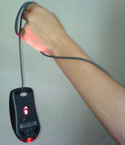Murphy's Law states: "Anything that can go wrong will go wrong." This is especially true and especially painful when there is an audience involved.
|
 Principle #6 states “If you’re not early, you’re late. A simple problem that would ordinarily not require anything more than time to fix can become a fatal error when the time isn’t available”. Principle #6 states “If you’re not early, you’re late. A simple problem that would ordinarily not require anything more than time to fix can become a fatal error when the time isn’t available”.
John Richardson posted a great story on Success Begins Today that illustrates why it’s imperative that you arrive at the venue early enough to test every file and every piece of critical equipment.
I put on my suit jacket, grabbed my MacBook Pro, walked up to the smart podium, connected up the projector cable and waited for my first slide to come up on the screen.
It didn’t connect
I fumbled with the cables, tried different keystrokes, and it still didn’t connect.
I started to sweat, thinking about weeks of work going up in smoke. The audience was getting restless. Here I am, a technology guy, having problems with my Mac and a projector. Pictures of Steve Jobs popped into my mind. Apple products just work… except when you are in front of a restless audience.
Finally, I was just about to give up, when my screen flashed. My first slide popped on the screen, the lights dimmed and I was ready to go. I walked out in front of the podium, addressed the audience, and clicked the button on my Apple remote to advance to the next slide.
Nothing happened
….
What had been a smooth story in my mind at home was now a real problem. I glanced over at the podium, hoping to see my presenters view on my laptop which would quickly show me the next slide. Unfortunately, the podium had a large back edge which blocked my view. I was now on my own. 30 slides to go.
….
Now the remote didn’t work again. I became a contortionist and held the remote behind my back and tried to aim it at the podium without looking. Talk about out of kilter, I had to be a spectacle to my audience.
….
I could not believe all of the problems that I encountered. We were in a brand new classroom, at a state of the art junior college, with some of the latest projection technology. Yet everything went wrong.
The interesting thing was, the next five presenters all had problems too.
 A couple weeks ago, I wrote about a time when the simplest of technologies, something we rarely give a second thought, gaffer tape, unexpectedly failed to do its job and caused a great deal of trouble. Geetesh Bajaj (an Microsoft PowerPoint MVP who also runs the incredibly useful site Indezine — “a platform for PowerPoint presentations, presentation software, image editing and clip media”) has been kind enough to share another story that again strongly suggests we need to think about even our humblest tools a little more often and a little more rigorously: A couple weeks ago, I wrote about a time when the simplest of technologies, something we rarely give a second thought, gaffer tape, unexpectedly failed to do its job and caused a great deal of trouble. Geetesh Bajaj (an Microsoft PowerPoint MVP who also runs the incredibly useful site Indezine — “a platform for PowerPoint presentations, presentation software, image editing and clip media”) has been kind enough to share another story that again strongly suggests we need to think about even our humblest tools a little more often and a little more rigorously:
There are many things you can do to avoid presentation disasters – yet there’s always something new that you learn each day.
When I got a new MacBook Pro with OS X Leopard, I knew I wanted to use this machine for my next presentation. Now my next presentation happened to include a training session on Microsoft PowerPoint 2007 and my entire audience was working on a Microsoft Windows platform (and not the Mac). Unperturbed, I installed a copy of Windows Vista on a new partition created by Boot Camp. Everything worked great – I also had PowerPoint 2007 working on Vista and it seemed to be working so much quicker than my older laptop. When everything works so flawlessly at the first go, you know there’s something wrong you have missed out somewhere!
 Well, that something ended up being the right-click option. The MacBook Pro has no right-click button. I could plug in a regular two-button mouse but it seemed too much to do when I already had the receiver for my remote plugged in – and for some reason, the mouse and the remote were not too happy with each other. It wasn’t a happy thought to use my older laptop again – and at this point of time, the older machine seemed like an archaic dinosaur that was so slow (funny how perceptions change in one day). Well, that something ended up being the right-click option. The MacBook Pro has no right-click button. I could plug in a regular two-button mouse but it seemed too much to do when I already had the receiver for my remote plugged in – and for some reason, the mouse and the remote were not too happy with each other. It wasn’t a happy thought to use my older laptop again – and at this point of time, the older machine seemed like an archaic dinosaur that was so slow (funny how perceptions change in one day).
Trust me – it’s not too easy to do advanced tasks in PowerPoint 2007 without the right-click – and even Shift + F10 wouldn’t work as a right-click here – the equivalent on the MacBook Pro was Fn + Shift + F10. By the time I managed to press all those three buttons, my cursor was elsewhere.
Luckily, the Internet saved me – a quick search got me pages where there were many, many users who faced the same problem. One user recommended a free program called Apple Mouse – this lets you Ctrl-click to simulate a right click. One quick download and five minutes later, everything worked great again.
So what’s the lesson I learnt here? That’s got to be that one needs to test all the obvious and unobvious issues before using them in a presentation environment. Imagine you are presenting now, and switch on your laptop and do all tasks you might have to do later. Even if you are in another city, time zone, or continent – it’s a good idea to use the same combination of presentation, laptop, and remote to test the flow. And even if the projector may be different, do plug it in if you have access to one.
We normally check the projections, the room, the lighting, even the cables and the sound systems. But for all you know, there might be a problem area that’s not as obvious! And maybe that’s staring at you now.
|
 Principle #6 states “If you’re not early, you’re late. A simple problem that would ordinarily not require anything more than time to fix can become a fatal error when the time isn’t available”.
Principle #6 states “If you’re not early, you’re late. A simple problem that would ordinarily not require anything more than time to fix can become a fatal error when the time isn’t available”. A couple weeks ago
A couple weeks ago Well, that something ended up being the right-click option. The MacBook Pro has no right-click button. I could plug in a regular two-button mouse but it seemed too much to do when I already had the receiver for my remote plugged in – and for some reason, the mouse and the remote were not too happy with each other. It wasn’t a happy thought to use my older laptop again – and at this point of time, the older machine seemed like an archaic dinosaur that was so slow (funny how perceptions change in one day).
Well, that something ended up being the right-click option. The MacBook Pro has no right-click button. I could plug in a regular two-button mouse but it seemed too much to do when I already had the receiver for my remote plugged in – and for some reason, the mouse and the remote were not too happy with each other. It wasn’t a happy thought to use my older laptop again – and at this point of time, the older machine seemed like an archaic dinosaur that was so slow (funny how perceptions change in one day).